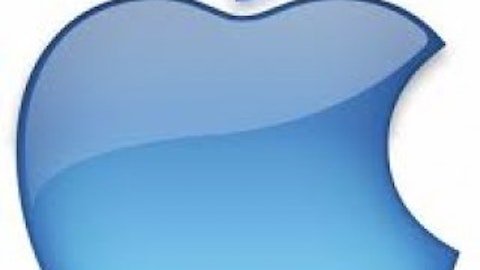Let’s make one fact clear: Apple Inc. (NASDAQ:AAPL) is not likely to grow as fast during the next five years as it did during the past five years. Annual growth of 70% is not sustainable forever, especially for a company that is expected to generate over $170 billion in revenue this fiscal year.
Analysts’ current expectations of 20% annual growth over the next five years are a more reasonable starting point for how to think about Apple going forward. As I wrote several months ago and will reiterate today, 20% growth combined with an unparalleled balance sheet simply can’t be reconciled with a price to earnings ratio of just 10.
Apple beat analyst expectations this quarter

Apple returns $100 billion to shareholders, and the market yawns
For years, one bearish view on Apple (and other companies with a sizable cash position) has been that the cash balance isn’t really relevant to the valuation of the company as a whole. The logic has been that the cash isn’t generating significant returns for the shareholder while it is sitting on the balance sheet, resulting in relatively low-performing assets weighing down the valuation multiple of a company. Alternatively, others argue that the net cash balance can be separated from the valuation of a company’s operations, but only at a discount.
I’ve argued that Apple Inc. (NASDAQ:AAPL)’s cash and operating assets should be valued separately, and that Apple’s $145 billion cash and investments should not be discounted unless it is receiving below-market interest rates. This model follows a well formulated case made by Aswath Damodaran on the subject of how to factor cash into the valuation of a company.
For those that continue to disagree with this philosophy, the use of Apple’s cash became significantly more clear (and near term) following Apple’s announcement that it will return $100 billion to shareholders during the next two years. This plan to maximize shareholder valuation includes the largest share buyback in history. Based on this stated plan to return cash to shareholders, the argument to value Apple Inc. (NASDAQ:AAPL)’s cash balance on a separate and undiscounted basis is even stronger than before even when factoring in some of the complications in repatriating portions of the cash balance.
Valuing Apple today
Apple has a current market capitalization of $404 billion; excluding cash and investments, this values Apple’s ongoing operations at $259 billion. Let’s take a quick look at Apple’s valuation metrics both including and excluding cash:
| Apple (Including Cash) | Apple (Excluding Cash) | |
|---|---|---|
| Market Capitalization (in billions) | $403.7 | $259.0 |
| TTM revenue (in billions) | $169.1 | $169.1 |
| TTM price to sales ratio | 2.39 | 1.53 |
| TTM earnings (in billions) | $39.7 | $38.3 |
| TTM price to earnings ratio | 10.17 | 6.76 |
| 5 Year expected growth rate | 20.9% | 20.9% |
| PEG ratio | 0.49 | 0.32 |
| TTM free cash flow (in billions) | $45.4 | $44.0 |
| TTM free cash flow yield | 11.2% | 17.0% |
| Source: Motley Fool CAPS and Yahoo! Finance – April 29, 2013 | ||
Excluding cash and the associated interest income of approximately $1.4 billion over the last 12 months, Apple Inc. (NASDAQ:AAPL) is trading at less than seven times earnings and less than six times free cash flow.
Apple is NOT Microsoft
Not only is Apple expected to grow more than twice as fast as Microsoft Corporation (NASDAQ:MSFT), the company is also trading at a discount to Microsoft using either valuation method above:
| Microsoft (Including Cash) | Microsoft (Excluding Cash) | |
|---|---|---|
| Market Capitalization (in billions) | $272.3 | $197.8 |
| TTM revenue (in billions) | $76.0 | $76.0 |
| TTM price to sales ratio | 3.58 | 2.60 |
| TTM earnings (in billions) | $16.4 | $15.8 |
| TTM price to earnings ratio | 16.60 | 12.52 |
| 5 Year expected growth rate | 8.5% | 8.5% |
| PEG ratio | 1.95 | 1.47 |
| TTM free cash flow (in billions) | $27.5 | $26.9 |
| TTM free cash flow yield | 10.1% | 13.6% |
| Source: Motley Fool CAPS and Yahoo! Finance – April 29, 2013 | ||
This comparison is clearly showing that Apple Inc. (NASDAQ:AAPL) is trading at a valuation that is significantly cheaper than Microsoft Corporation (NASDAQ:MSFT). I’d argue that this makes absolutely no sense given each company’s current product mix and future opportunity; that is not necessarily a criticism of Microsoft (or its current valuation), but is instead an indication of just how underpriced Apple’s shares are.
What does the future hold?
Most Apple Inc. (NASDAQ:AAPL) skeptics point to the recent decline in gross margin as a sign that Google Inc (NASDAQ:GOOG) and its Android operating system are poised to win the battle for mobile computing dominance. Google and its hardware partners are formidable competitors, but there is no reason to believe that only one platform will thrive over the long haul (both in terms of market share and share price performance). Furthermore, recent data points to Apple gaining market share in the U.S. despite the usual lull as the previous generation of iOS devices prepares for a refresh. It sounds more than a little bit premature to predict the collapse of Apple’s mobile market share.
In addition to hardware sales, there are often arguments that the Google Inc (NASDAQ:GOOG) Play app store or Amazon.com, Inc. (NASDAQ:AMZN)‘s suite of digital music and video apps will bring an end to iTunes’ dominance. Again, this argument is based on the premise that there can only be one winner and conveniently ignores the fact that the entire app marketplace is poised for fantastic growth. Despite this sense of imminent doom, Apple reported record iTunes revenue of $4.1 billion in the past quarter, including $2.4 billion from the sale of media.
And finally, Apple Inc. (NASDAQ:AAPL)’s shares are being pressured because the market demands to know what the “next big thing” will be. Despite plenty of runway left in the existing product lines (iPad sales rose 65% year-over-year), analysts are simultaneously expecting 20% growth while pricing the stock as if no new products will be released. Whether it is iWatch, iTV, or something completely different, Apple is continuing to innovate.
For potential investors who won’t take that statement at face value and demand specifics, consider this: Apple has spent over $1 billion in each of the past two quarters on research and development; this tremendous commitment represents more than a 30% increase over the prior year. Is it more reasonable to think that a company with a proven history of innovation will continue to innovate with this huge budget, or is the pipeline really dry as some fear?
Apple is cheap!
It is getting harder and harder to argue that Apple Inc. (NASDAQ:AAPL)’s stock is overpriced. Meanwhile, the simplified valuation comparison depicted above shows just how easy it is to argue that Apple’s stock is significantly underpriced. How underpriced? That is certainly a matter of opinion. However, Apple’s current position seems to warrant at least a valuation comparable to Microsoft Corporation (NASDAQ:MSFT). Excluding cash and short-term investments, Microsoft is trading at a TTM P/E of 12.5 as noted above; applied to Apple, that would suggest a valuation (excluding cash) of $480 billion.
Adding back Apple’s cash balance of $145 million, this implies a share price of approximately $665. While $665 represents a sizable premium of 55% over today’s share price, this methodology assumes that Apple and Microsoft Corporation (NASDAQ:MSFT)should trade at the same price to earnings multiple. Even more upside exists if you agree with the premise that Apple will continue to grow faster than Microsoft for the foreseeable future.
Is it really reasonable to value Apple Inc. (NASDAQ:AAPL) more cheaply than Microsoft Corporation (NASDAQ:MSFT)? I don’t believe so!
The article Apple Is NOT Microsoft! originally appeared on Fool.com and is written by Brian Shaw.
Copyright © 1995 – 2013 The Motley Fool, LLC. All rights reserved. The Motley Fool has a disclosure policy.



